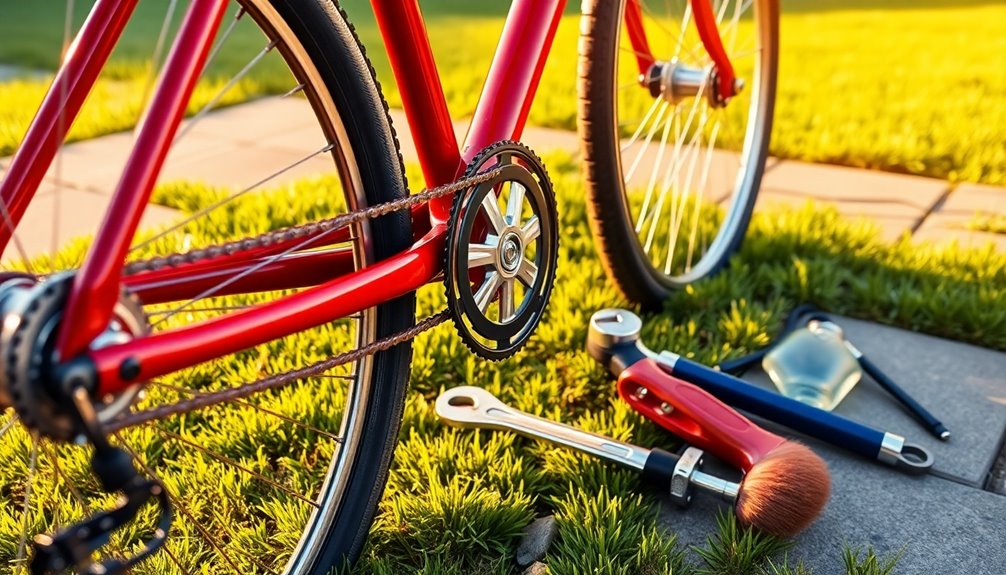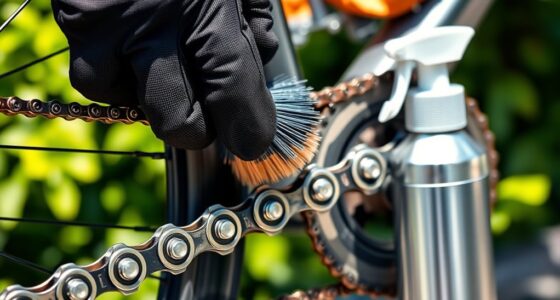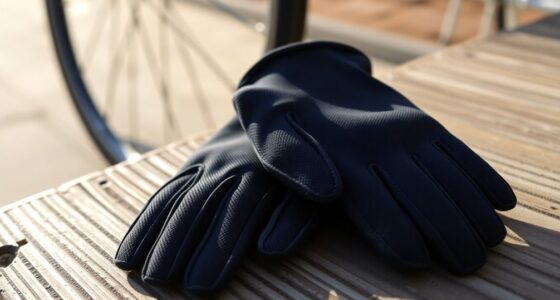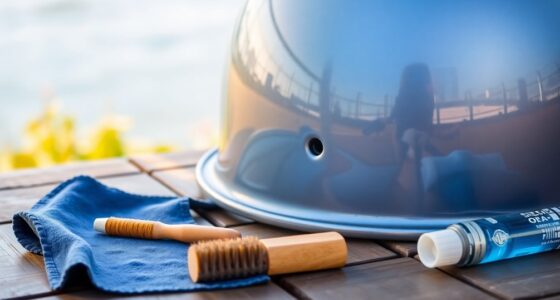To keep your bike in top shape, regular preventative maintenance is essential. Start with the ABC check: inspect tire air pressure, test your brakes, and lubricate the chain. Clean your bike often, using the right tools and supplies. Don't forget to maintain your tire pressure and check the chain for wear. Brake inspection is vital too. If you want to learn more about how to conquer maintenance fears and enhance your bike's longevity, you'll find useful tips ahead.
Key Takeaways
- Regularly perform the ABC bike check to ensure air pressure, brake function, and chain condition are optimal for safe riding.
- Clean and lubricate your bike chain frequently to enhance performance and prevent wear; a full degreasing is ideal every few weeks.
- Inspect and maintain tire pressure weekly, adjusting based on riding conditions to minimize the risk of flats and enhance ride quality.
- Conduct thorough brake inspections, checking pad wear and cable conditions to ensure reliable stopping power and safety on rides.
- Store your bike indoors and clean it before long-term storage to prevent rust and prolong its lifespan.
Importance of Regular Maintenance
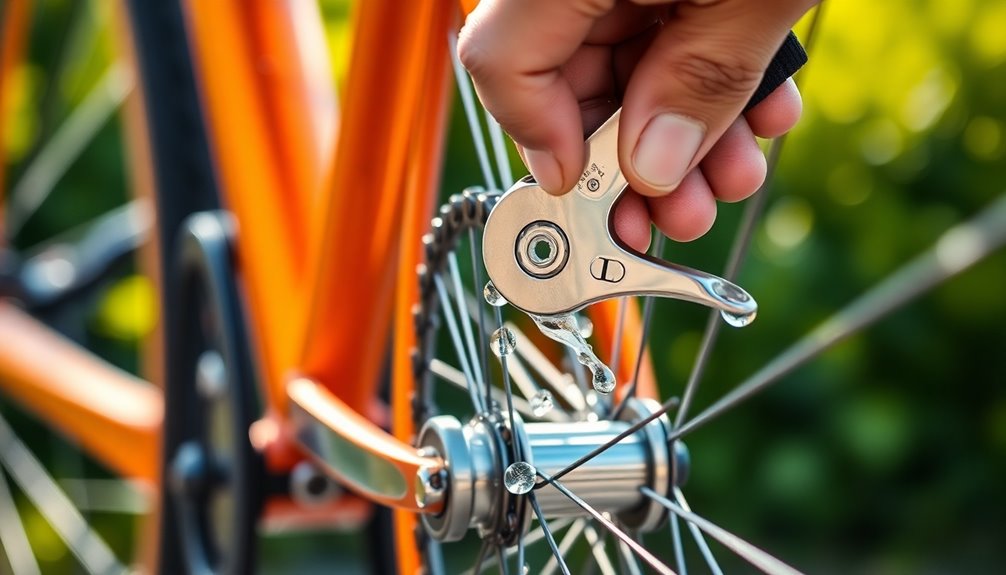
When you prioritize regular maintenance for your bike, you're not just keeping it clean; you're greatly enhancing its performance and lifespan.
Consistent bike maintenance allows you to catch signs of wear early, preventing small issues from becoming major problems. By checking essential components like brake pads and tires, you guarantee not only your bike's reliability but also your safety.
Seasonal maintenance helps prepare your bike for peak riding months, reducing the risk of breakdowns when you need it most. Remember, a complete overhaul at least once a year is vital to keep everything running smoothly. Additionally, ensure that you regularly check air pressure in your tires to maintain optimal performance and longevity.
The ABC Bike Check: Air, Brakes, Chain
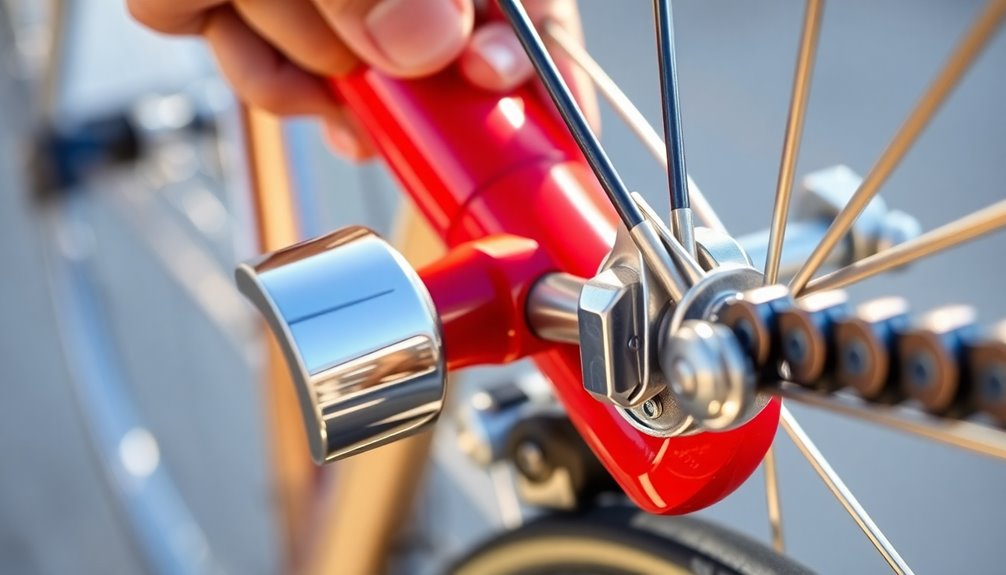
Regular maintenance sets the stage for a safe and enjoyable ride, but it's important to perform a quick check before you hit the road.
The ABC Bike Check focuses on three critical components: Air, Brakes, and Chain. Here's what you should inspect:
- Air: Confirm your tire pressure feels firm; check the recommended PSI on the sidewall.
- Brakes: Test brake levers to confirm they engage smoothly and check for worn pads.
- Chain: Verify the chain runs smoothly and is properly lubricated.
- Front and Rear Brakes: Check the braking action independently for balanced stopping power.
- Visual Inspection: Look for any visible damage or wear on these components.
Cleaning and Lubricating Your Bike
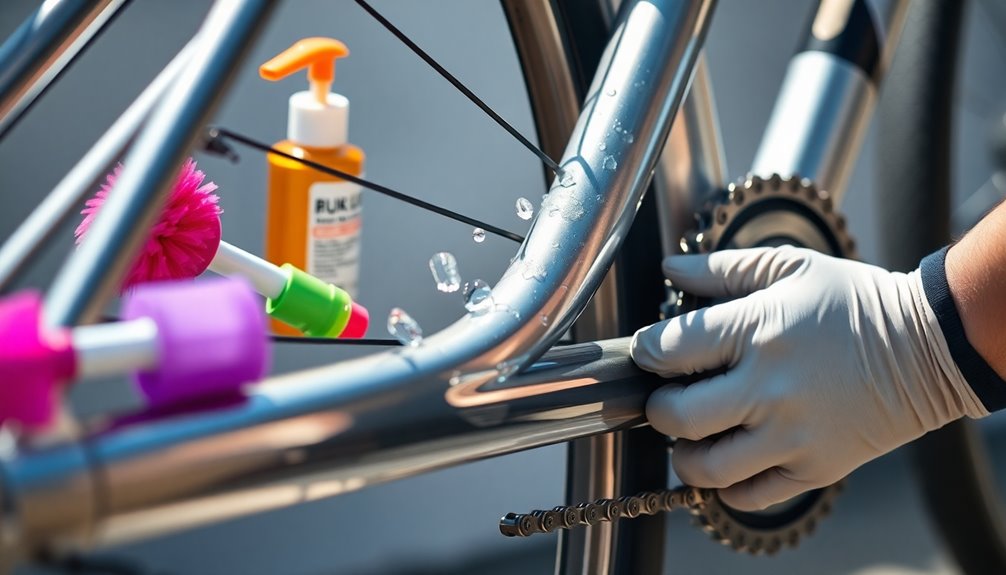
Cleaning and lubricating your bike is essential for maintaining its performance and longevity.
Regularly clean your bike chain to guarantee smooth operation; a full degreasing is recommended every couple of weeks, especially for daily riders. Use a bike-specific degreaser and a chain cleaning device to thoroughly clean the drivetrain.
Regularly degrease your bike chain every few weeks, especially if you ride daily, for optimal performance.
Remember, over-lubrication can attract dirt, so always wipe off excess lubricant before hitting the road.
Don't forget to inspect and lubricate your brake and derailleur cables regularly to keep them responsive during rides.
After winter rides, a quick rinse can help prevent long-term damage from road grit.
Stick to a regular cleaning schedule based on your riding conditions for the best results.
Basic Supplies for Maintenance

To keep your bike in top shape, you'll need some essential supplies.
Start with cleaning tools, lubrication products, and a maintenance toolkit to tackle any issues that arise.
Having these items on hand makes it easier to perform regular upkeep and enjoy a smoother ride.
Essential Cleaning Tools
When it comes to bike maintenance, having the right cleaning tools is essential for keeping your ride in top shape.
Investing in essential cleaning supplies not only helps you clean your bike effectively but also prolongs its lifespan.
Here are some must-have tools for your maintenance kit:
- Clean rags for grease and oil
- Brushes of various sizes for hard-to-reach areas
- Bike-specific degreasers for gummy parts
- A bike pump with a pressure gauge
- Specialized bike cleaning products
Using these tools will guarantee your bike chain remains clean and functions smoothly.
Lubrication Supplies Needed
After ensuring your bike is clean and free of grime, the next step in maintenance focuses on lubrication.
To keep your bike running smoothly, gather essential lubrication supplies. A bike-specific degreaser is vital for effectively cleaning gummy parts without harming the bike's finish. Use it alongside clean rags to remove grease and oil.
Don't forget to have various sizes of brushes handy for those hard-to-reach areas in your drivetrain.
Once everything is clean, apply chain lube—available in wet or dry formulations—to maintain a smooth-running drivetrain and extend your chain's lifespan.
Just remember to wipe off any excess lubricant before riding to prevent attracting dirt and causing performance issues.
Happy riding!
Maintenance Tool Kit
A well-equipped maintenance tool kit is essential for any cyclist looking to keep their bike in top condition. With the right supplies, you can tackle most common issues and guarantee a smooth ride.
Here are five must-have items for your maintenance tool kit:
- Bike multitool for quick adjustments
- Reliable bike pump with pressure gauge
- Clean rags for wiping down components
- Puncture repair kit with levers and patches
- Various-sized brushes for cleaning hard-to-reach areas
Regularly checking your tire pressure with that bike pump will enhance your riding experience.
Plus, keeping your tools organized and replacing worn-out items will make your bike maintenance routine more efficient.
Invest in these essentials to keep your bike running smoothly!
Tire Pressure Maintenance
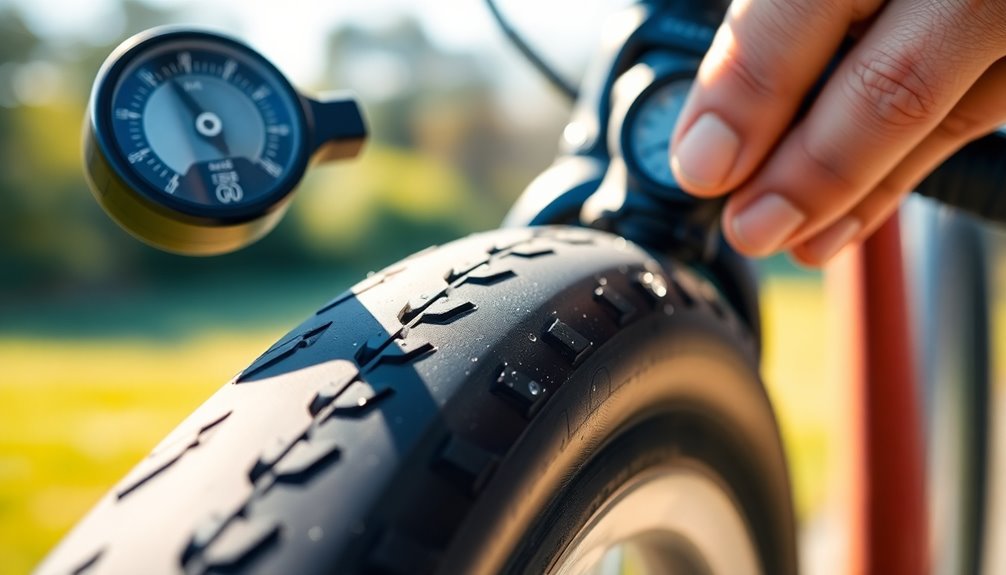
Maintaining proper tire pressure is essential for your bike's performance and safety, especially since tires naturally lose air over time. Regularly check your tire pressure at least once a week to avoid pinch flats and guarantee peak performance. The recommended PSI is usually printed on the tire sidewall.
| Condition | Recommended PSI |
|---|---|
| Road Cycling | 80-130 |
| Off-Road Riding | 30-50 |
| Commuting | 60-80 |
| Touring | 50-70 |
Invest in a pump with a built-in pressure gauge for accurate readings. Adjusting tire pressure based on riding conditions keeps your bike in top shape, enhances ride quality, and reduces the risk of blowouts.
Chain Care
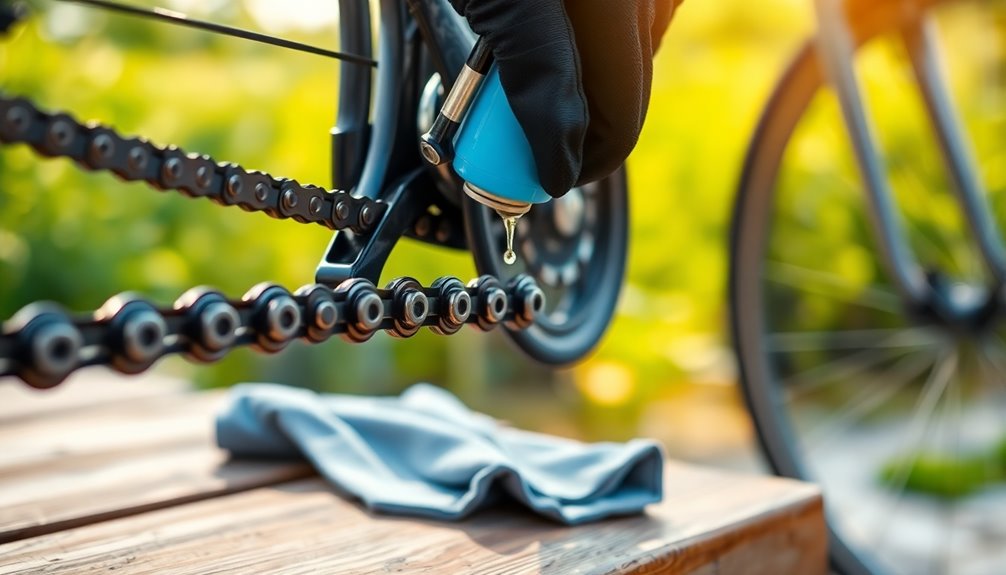
Taking care of your bike chain is essential for smooth rides.
You should regularly clean it, lubricate it when needed, and watch for any signs of wear.
Chain Cleaning Techniques
Cleaning your bike chain every couple of weeks is essential for peak performance and longevity.
Using the right chain cleaning techniques helps prevent wear and guarantees smooth rides. Here are some tips to keep your chain in top shape:
- Use a bike-specific degreaser to remove grime.
- Consider a chain cleaning device for heavy dirt.
- Check for wear indicators and replace the chain if it's stretched.
- Clean more frequently during winter to combat road salt.
- Wipe off excess lubricant after applying to avoid attracting dirt.
If you're unsure about cleaning methods or need supplies, don't hesitate to visit your local bike shop.
Keeping your chain clean not only enhances performance but also extends its life.
Lubrication Frequency Guidelines
To keep your bike chain in prime condition, you'll want to lubricate it every 100-150 miles, especially if you're riding in wet or muddy conditions. This prevents dirt accumulation and minimizes wear.
Always clean your chain before lubrication to avoid mixing dirt and grime with the lubricant, which can lead to additional wear on the chain and bike frame.
Use a bike-specific lubricant—wet for wet conditions and dry for dry—to guarantee peak performance and corrosion protection.
After applying, remember to wipe off any excess lubricant, as over-lubrication can attract dirt and debris.
Regular inspections for signs of wear, like a squeaky chain or rust, will help you identify when lubrication is overdue or when replacement might be necessary.
Signs of Wear
While enjoying your ride, it's important to stay attentive to signs of wear on your bike chain. A worn chain can lead to poor performance, affecting your rear derailleur and overall ride quality.
Regular checks can save you from costly repairs down the road. Look out for these key indicators:
- Excessive elongation over 0.5%
- Squeaking or grinding noises while pedaling
- Rust or corrosion, especially after wet rides
- Stiff links that don't move freely
- A worn brake that affects braking efficiency
Taking the time to inspect your chain helps maintain peak performance and prolongs its life.
Clean and lubricate regularly to guarantee smooth shifting and keep your bike running smoothly.
Brake Inspection
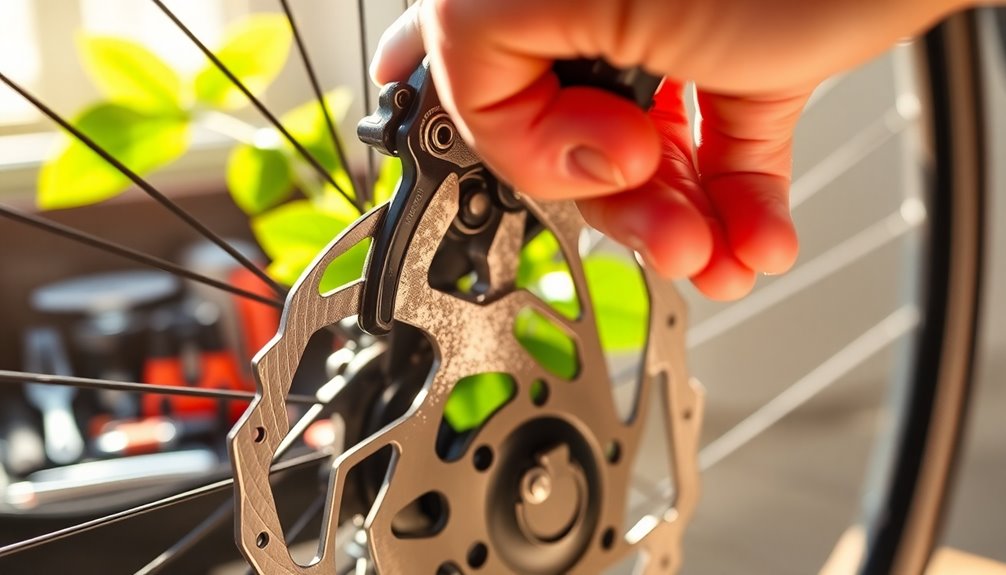
Regular brake inspection is essential for your safety and bike performance.
Start by checking your brake pads for wear; if they've fallen below the wear line, replace them to guarantee effective stopping power. Accumulated grit can quickly grind them down, so clean them frequently to maintain safety.
Check your brake pads regularly; replace them if worn below the line and clean off any grit for optimal safety.
Next, test your brake levers independently for both the front and rear brakes to verify they engage smoothly without delay.
Inspect the brake cables for any fraying or corrosion; replace them if you spot any damage to prevent brake failure.
Finally, confirm your brake calipers are properly aligned with the wheel rim. Misalignment can lead to uneven wear and decreased efficiency, compromising your overall braking performance.
Overcoming Maintenance Fears and Storage Care

Many cyclists feel intimidated by bike maintenance, but tackling these tasks can be straightforward and rewarding. You can easily learn essential skills like checking tire pressure and cleaning the chain, which boosts your confidence over time.
Here are some tips to overcome maintenance fears and guarantee proper storage care:
- Keep a basic bike multitool and puncture repair kit handy.
- Store your bike indoors to prevent rust and corrosion.
- Regularly inspect your storage conditions to maintain bike health.
- Clean all components before long-term storage and consider using a cover.
- Conduct a quick inspection before each ride for loose bolts and chain condition.
Frequently Asked Questions
How Do You Maintain a Fat Bike?
To maintain your fat bike, start by regularly checking and adjusting tire pressure for peak traction, especially in snowy or sandy conditions.
Clean the drivetrain often to prevent wear, using a bike-specific degreaser.
Inspect and lubricate the chain to avoid rust, particularly during winter rides.
Don't forget to check brake pads and tighten all bolts before rides to make certain everything operates smoothly.
Keeping these components in shape will enhance your biking experience.
What Regular Maintenance Should Be Done on a Bike?
To keep your bike in great condition, start with an ABC Bike Check before every ride.
Check air pressure, brakes, and chain function. Clean and lubricate your chain every couple of weeks, and inspect brake pads monthly for wear.
Don't forget to check tire pressure weekly, adjusting it to the recommended PSI.
Finally, every six months, inspect cables, quick release parts, and wheel spokes to catch any potential issues early.
How to Maintain Your Bicycle in Good Condition?
To maintain your bicycle in good condition, start with the ABC Bike Check before each ride—ensure your air, brakes, and chain are all functioning properly.
Clean and lubricate your chain regularly to avoid wear.
Inspect your brake pads monthly, replacing them as needed.
Keep an eye on tire pressure weekly, storing your bike indoors to prevent rust.
Finally, perform a thorough cleaning and inspection every six months or after 500 miles.
How Do I Keep My Bike in Good Condition?
To keep your bike in good condition, start with the ABC Bike Check before every ride—make sure your air pressure, brakes, and chain are all in top shape.
Clean it regularly with bike-specific products to prevent dirt buildup. Check your brake pads monthly and replace them as needed.
Don't forget to inspect tire pressure weekly and perform a thorough overhaul at least once a year for long-lasting performance.
Conclusion
By staying on top of your bike's maintenance, you'll keep it running smoothly, much like a well-tuned engine. Regular checks and simple tasks like cleaning and lubricating not only enhance your ride but also extend your bike's lifespan. Don't let maintenance fears hold you back; treating your bike with care is as satisfying as a long, scenic ride. So gear up, invest some time, and enjoy the freedom of a well-maintained bike!
